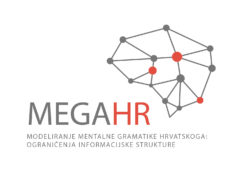The significance of specialized knowledge in rating concreteness in context
Maja Anđel, Anita Peti-Stantić, Mateusz-Milan Stanojević
There are concreteness/abstractness rating lists for a variety of languages (e.g. Brysbaert et al. 2014). These ratings tend to be relatively stable across different adult participants (age, gender) and different languages, even when different scales and instructions are used, and can be reliably modeled using computational modeling (cf. Peti-Stantić et al. 2021 for a Croatian example). Concreteness effects – advantages in processing words rated as concrete – are also relatively reliable across tasks (priming, lexical decision). However, in all these cases, the ratings have been obtained on words in isolation rather than in context, and therefore they do not take into consideration potential polysemy or the fact that context-free estimates rely on the participants imagining an idealized minimal context (Löhr 2021). Thus, the similarity in the scores may be due to similar mechanisms of defaulting to a minimal context for individual words across participants. The question is whether the situation would change when concreteness is rated in context, with contextual information potentially favoring one group of participants because of their specialist knowledge. More specifically, will specialists rate a specific and contextualized example related to their field (e.g. električna energija ‘electric energy’) as more concrete than an individual word (energija ‘energy’), and will the concreteness effects of such combinations be more evident in lexical decision tasks?
To test this, we performed four related experiments with 60 university students, 30 majoring in a STEM area, and 30 in the humanities. The participants completed two rating tasks (nouns in isolation and in two-word phrasal contexts) and two lexical decision tasks (one with individual words and one primed with two-word phrasal contexts). In all the experiments 60 nouns from the Croatian Psycholinguistic Database (Peti-Stantić et al. 2019) were used. The nouns were selected based on their concreteness ratings in the CPD database (high vs. low concreteness) as well as whether they could potentially combine with pre- or postmodifiers to form STEM-specific two-word combinations. The combinations were extracted from hrWaC, a 1.4 billion corpus of Croatian. This resulted in constructions such as električna energija ‘electric energy’ and kreativna energija ‘creative energy’ (where a potentially ambiguous abstract noun energija ‘energy’ appears in a STEM-specific and general combination; a similar high-concreteness word is ključ which appears in the specific combination francuski ključ ‘adjustable wrench’), as well as žuta jabuka ‘yellow apple’ and trula jabuka ‘rotten apple’ (constructions with the concrete noun jabuka ‘apple’ which is not potentially ambiguous; a similar non-ambiguous abstract noun is pristup ‘access’).
The results of the rating tasks show that the overall concreteness ratings of the stimulus words in isolation are highly correlated with the results in the MEGAHR database (r = .97, p < .001), suggesting that they are reliable. Participants majoring in STEM rated the words as slightly more concrete than participants majoring in the humanities, but the effect size was minimal (F = 4.997, p = .03, df = 1, η2 = 0.003). There were no differences between ratings of potentially ambiguous vs. unambiguous words between the two groups of participants.
Participants from the STEM group rated contextualized phrases overall as more concrete than participants from the humanities (F = 36.23, p < .001, df = 1, η2 = 0.06, moderate effect size). There is also a general effect of whether the word belongs to the STEM vocabulary (F = 15.19, p < .001, df = 1, η2 = 0.02, small effect size), and post-hoc tests show that STEM participants rated words belonging to the STEM vocabulary as significantly more concrete than the humanities participants.
In the lexical decision task with individual words, in line with previous research, all participants reacted more quickly to concrete words than to abstract words. The humanities group reacted more quickly across the board (F = 22.04, p < .001, df = 1, η2 = 0.07, moderate effect size), but there was no effect of word ambiguity. There were no significant differences in the reaction times of the humanities and STEM participants to ambiguous and unambiguous words in the priming task.
Overall, these results suggest that the semantic combinatorial potential of words does not influence their concreteness ratings when they are presented in isolation. However, differences arise when specialists rate specialist contextualized combinations, which they find more concrete than non-specialists, and rate as more concrete than non-specialized combinations. This suggests that concreteness values are not stable when rated in context (rather than in isolation) and that they may depend on participant knowledge (specialist vs. non-specialist). In contrast, when tested in isolation, the results seem to default to an idealized widely shared minimal context. Reaction times do not seem to tap into the same semantic factors, and may be related to participant characteristics; however more research is required. We will explore what the results mean from the point of view of the Dual Coding Theory (e.g., Paivio 2010).
References
Brysbaert, Marc, Amy Beth Warriner, and Victor Kuperman. 2014. ‘Concreteness Ratings for 40 Thousand Generally Known English Word Lemmas’. Behavior Research Methods 46 (3):904–11. https://doi.org/10.3758/s13428-013-0403-5.
Löhr, Guido. 2021. “What Are Abstract Concepts? On Lexical Ambiguity and Concreteness Ratings.” Review of Philosophy and Psychology, March. https://doi.org/10.1007/s13164-021-00542-9.
Paivio, Allan. 2010. ‘Dual coding theory and the mental lexicon’. The Mental Lexicon; 5 (2); 205–230.
Peti-Stantić, Anita, Maja Anđel, Vedrana Gnjidić, Gordana Keresteš, Nikola Ljubešić, Irina Masnikosa, Mirjana Tonković, Jelena Tušek, Jana Willer-Gold, and Mateusz-Milan Stanojević. 2021. “The Croatian Psycholinguistic Database: Estimates for 6000 Nouns, Verbs, Adjectives and Adverbs.” Behavior Research Methods, April. https://doi.org/10.3758/s13428-020-01533-x.
Peti-Stantić, Anita, Mateusz-Milan Stanojević, Maja Anđel, Mirjana Tonković, Gordana Keresteš, Nikola Ljubešić, Jana Willer Gold, Jelena Tušek, Irina Masnikosa, and Vedrana Gnjidić. 2019. “Hrvatska psiholingvistička baza.” Modeliranje mentalne gramatike hrvatskoga: ograničenja informacijske strukture. https://doi.org/10.17234/megahr.2019.hpb.
794 total views, 2 views today
This post is also available in:  Hrvatski (Croatian)
Hrvatski (Croatian)

